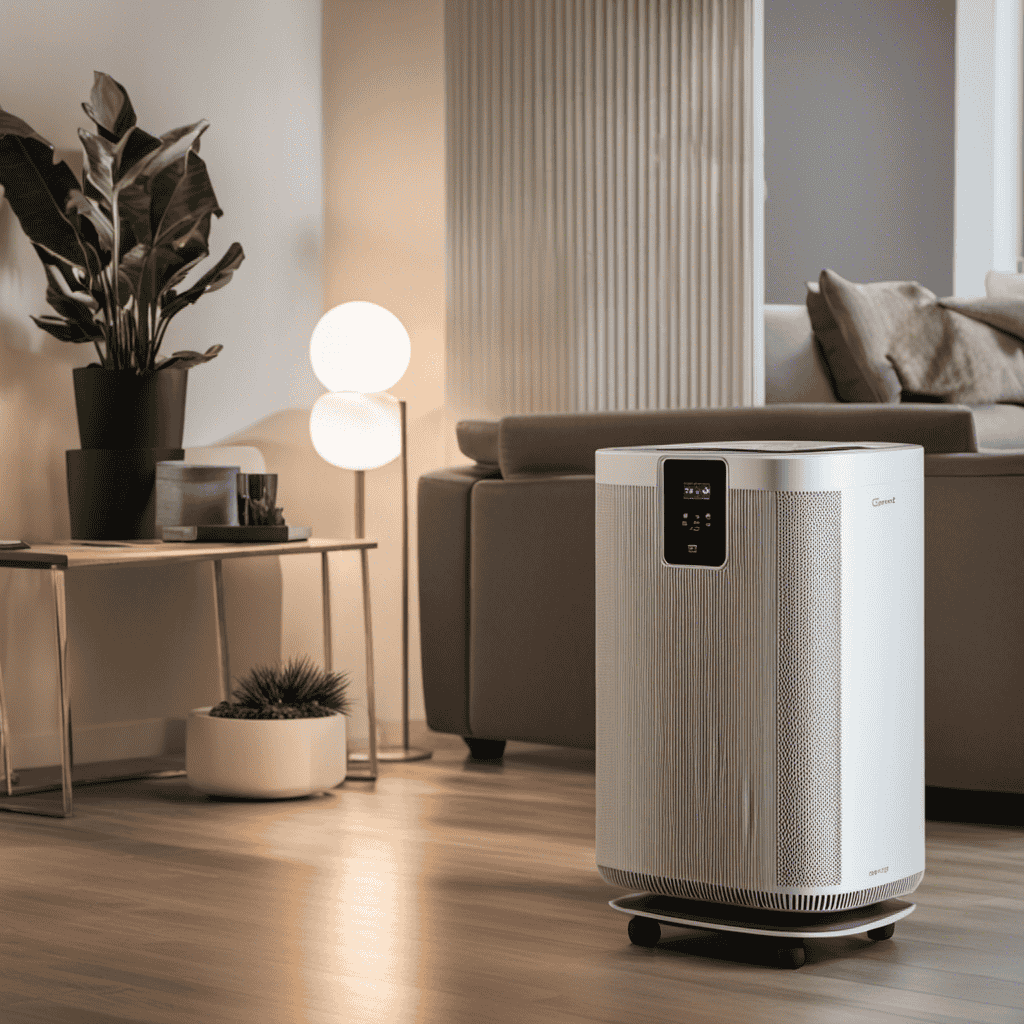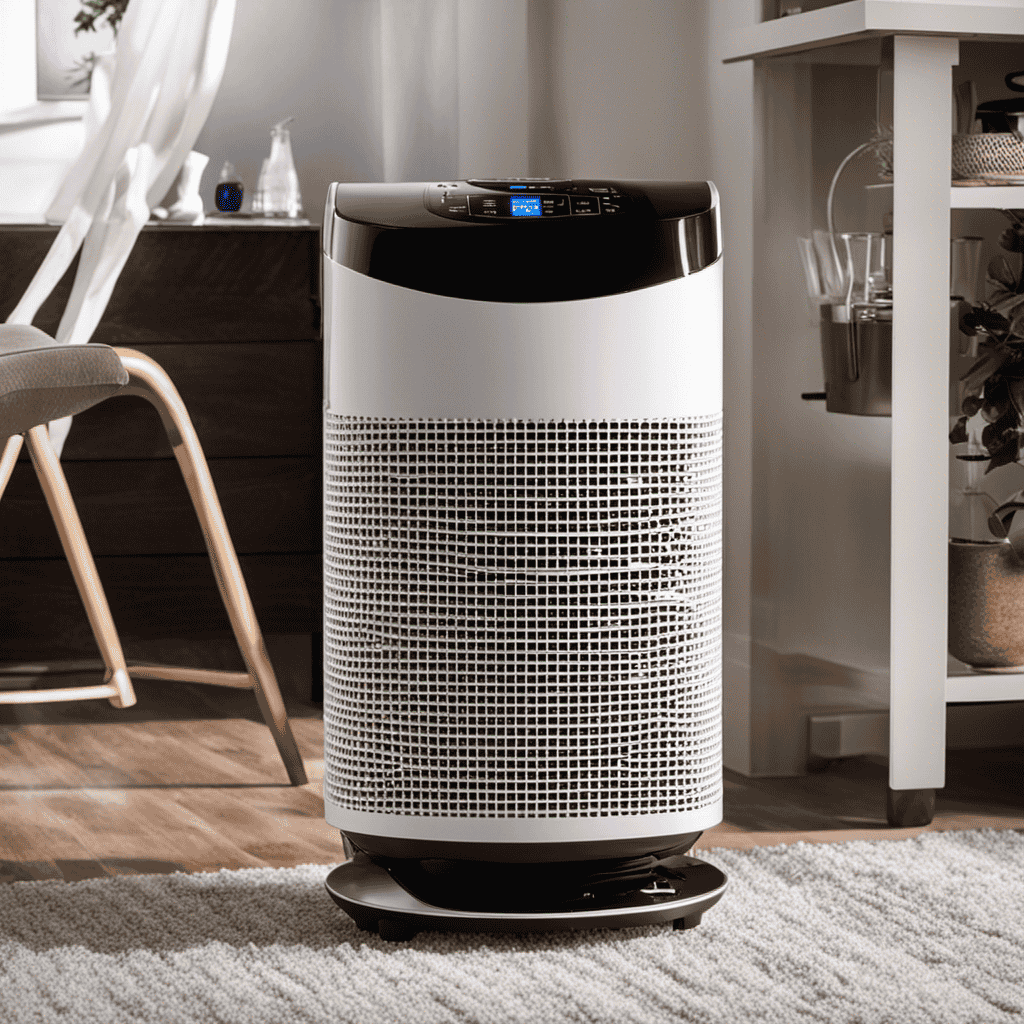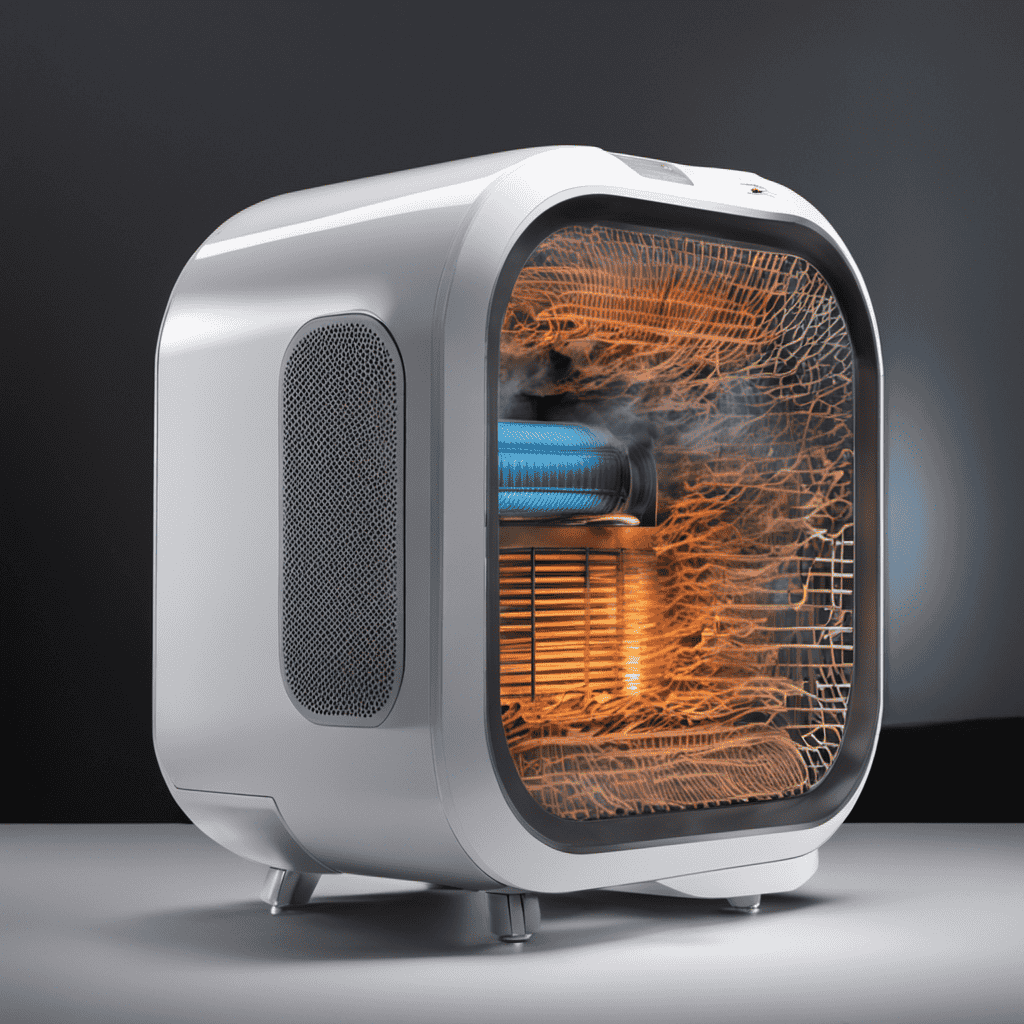Hello there!
Have you ever wondered how to work an air purifier? Well, wonder no more!
In this article, I’ll guide you through the process of setting up and using your air purifier like a pro. We’ll cover everything from understanding the control panel to maximizing its efficiency.
So, if you’re ready to breathe cleaner air and improve the overall air quality in your space, let’s dive right in!
Key Takeaways
- Setting up and operating the air purifier: Locate the air filter compartment, insert the air filter securely, plug in the power cord, and turn on the unit.
- Understanding the Control Panel: Familiarize yourself with the functions and settings on the control panel, adjust air flow settings, and pay attention to filter indicators and customization options.
- Choosing the right settings for air purification: Select the appropriate fan speed based on room size and air pollution level, and choose the appropriate mode for efficient air purification.
- Replacing and maintaining air filters: Regularly check and replace filters for optimal performance, consider different types of air filters available, and understand the benefits of using air filters for improved indoor air quality.
Setting up the Air Purifier
Now, let’s start by setting up your air purifier.
The first step is to locate the air filter compartment, usually located at the back or side of the unit. Open the compartment and carefully insert the air filter, making sure it fits securely.
Next, plug in the power cord and turn on the unit. You should hear a slight humming sound, indicating that the purifier is working. If you encounter any issues, such as the purifier not turning on or producing strange noises, refer to the troubleshooting section in the user manual.
Understanding the control panel is essential for operating the air purifier effectively, so let’s move on to the next section and explore its various functions and settings.
Understanding the Control Panel
To begin, take a look at the control panel and familiarize yourself with its various functions and settings. Understanding the control panel is essential for effectively operating an air purifier.
Here are three key points to consider:
-
Adjusting air flow: The control panel allows you to adjust the air flow settings according to your preference. You can increase or decrease the fan speed to regulate the amount of air being purified.
-
Understanding filter indicators: The control panel also features filter indicators that provide crucial information about the condition of the filters. These indicators will notify you when it’s time to clean or replace the filters, ensuring optimal performance.
-
Customizing settings: Some air purifiers offer additional customization options on the control panel, such as setting timers or activating specific modes like sleep mode or turbo mode.
Selecting the Right Fan Speed
To select the right fan speed, you’ll want to consider factors such as the size of the room and the level of air pollution.
Different fan speeds offer various benefits for your air purifier.
The first factor to consider is the size of the room. A larger room may require a higher fan speed to effectively circulate and purify the air. On the other hand, a smaller room may only need a lower fan speed to achieve the same results.
Another factor to consider is the level of air pollution. If the air pollution is high, a higher fan speed can quickly filter out pollutants and improve indoor air quality. However, if the air pollution is low, a lower fan speed can still maintain clean air while conserving energy.
Considering these factors will ensure that you choose the appropriate fan speed for your air purifier.
In the subsequent section, we will discuss choosing the appropriate mode for optimal air purification.
Choosing the Appropriate Mode
When selecting the appropriate mode for your air purifier, consider factors such as the level of air pollution and the size of the room. To make the right choice, keep in mind the following:
-
Choosing air purifier size: Ensure that the air purifier you select is suitable for the size of the room. A small purifier may not be effective in a large space, while a large purifier may be unnecessary for a small room.
-
Comparing different air purification technologies: There are various air purification technologies available, such as HEPA filters, activated carbon filters, and ionizers. Each technology has its own benefits and limitations. Research and compare these technologies to find the one that best suits your needs.
By considering the level of air pollution and the size of the room, you can select the appropriate mode that will efficiently clean the air in your space.
Now, let’s move on to adjusting the timer settings for optimal performance.
Adjusting the Timer Settings
By adjusting the timer settings, you can easily control the operating hours of your air purifier. Using the timer feature, you can set specific times for your air purifier to turn on and off, ensuring that it runs only when needed and conserves energy.
To adjust the timer settings, start by locating the timer button on your air purifier’s control panel. Press the button to enter the timer menu. Use the arrow buttons to set the desired start time and end time for your air purifier. Once you have set the timer, press the timer button again to save the settings.
Troubleshooting timer issues can be done by checking if the timer is correctly set and if there are any conflicting settings that may be causing issues.
Replacing the Air Filters
When it comes to maintaining an air purifier, two important aspects to consider are the filter replacement frequency and the types of air filters available.
The filter replacement frequency depends on factors such as the air quality in your environment and the usage of the air purifier.
Different types of air filters, such as HEPA filters and activated carbon filters, serve specific purposes in capturing and eliminating different pollutants from the air.
Filter Replacement Frequency
To ensure optimal performance, you should regularly check and replace the filters in your air purifier. The lifespan of air filters can vary depending on the model and usage, but on average, they should be replaced every 3 to 6 months. Regular filter replacement offers several benefits:
-
Improved air quality: Over time, air filters become clogged with dust, allergens, and other particles. By replacing them regularly, you ensure that your air purifier can effectively remove these contaminants, improving the indoor air quality.
-
Increased energy efficiency: Clogged filters can restrict airflow and make the air purifier work harder, consuming more energy. By replacing the filters, you help maintain the efficiency of your air purifier, reducing energy consumption and saving money on electricity bills.
-
Prolonged lifespan of the air purifier: Regular filter replacement prevents the accumulation of debris and reduces strain on the purifier’s motor. This can extend the lifespan of the device, ensuring it operates effectively for years to come.
Types of Air Filters
If you’re looking for an effective air filter, consider the different types available on the market. Air filters are an essential component of air purifiers, helping to remove airborne particles and improve indoor air quality. There are several types of air filters, each offering their own benefits and advantages. Here is a comparison table of different air filter brands and their key features:
| Brand | Type | Benefits |
|---|---|---|
| Honeywell | HEPA | Captures 99.97% of particles |
| Blueair | Carbon | Removes odors and chemicals |
| GermGuardian | UV-C | Kills germs and bacteria |
Using air filters has numerous benefits, such as reducing allergies, removing pet dander, and eliminating smoke and odors. Different air purifier brands offer a variety of filters to choose from, allowing you to find the one that best suits your needs. So, don’t underestimate the power of a good air filter in improving the air quality in your home or office.
Cleaning and Maintaining the Air Purifier
When it comes to maintaining an air purifier, there are a few key points to keep in mind.
First, it is important to understand the filter replacement frequency for your specific model. This can vary depending on factors such as usage, air quality, and the type of filter being used.
Additionally, knowing the proper cleaning techniques and tools will help ensure optimal performance and longevity of your air purifier.
Filter Replacement Frequency
You should check the filter replacement frequency of your air purifier regularly. Regular filter maintenance offers several benefits, such as improved air quality and increased lifespan of the purifier.
Here are three signs that indicate the need for filter replacement:
-
Reduced airflow: If you notice that the air purifier is not circulating air as efficiently as before, it may be a sign that the filter is clogged and needs to be replaced.
-
Increased dust and allergens: If you find that there is an increase in dust or allergy symptoms in your home, it could be an indication that the filter is no longer effectively trapping particles.
-
Foul odors: A strong, unpleasant smell coming from the purifier may suggest that the filter is saturated with contaminants and should be replaced.
Regularly checking and replacing the filter ensures optimal performance of your air purifier. Now, let’s move on to the next section, where we will discuss cleaning techniques and tools.
Cleaning Techniques and Tools
Regularly cleaning and maintaining your air purifier using appropriate techniques and tools is essential for its optimal performance. To keep your air purifier in top condition, there are a few maintenance tips to follow.
First, make sure to unplug the unit before cleaning. Then, use a soft, dry cloth to wipe down the exterior and remove any dust or dirt. For the filters, check the manufacturer’s instructions for the recommended cleaning supplies. Some filters can be rinsed with water, while others may require vacuuming or replacement. It’s important to clean or replace the filters regularly to ensure efficient air purification.
By taking these maintenance steps, you can prolong the lifespan of your air purifier and keep the air in your home clean and fresh.
Now let’s move on to troubleshooting common issues.
Troubleshooting Common Issues
If your air purifier isn’t working properly, there are common issues that can be easily troubleshooted. Here are some troubleshooting tips to help you identify and resolve the problems:
-
Check the power source: Make sure that the air purifier is properly plugged into a working electrical outlet. If the power cord is damaged, replace it with a new one.
-
Resolve unusual odors: If you notice strange odors coming from your air purifier, it could indicate that the filter needs to be replaced. Refer to the manufacturer’s instructions on how to properly replace the filter.
-
Clean the unit: Dust and debris can accumulate on the air purifier, affecting its performance. Regularly clean the exterior and interior components of the unit as per the manufacturer’s recommendations.
Maximizing the Efficiency of Your Air Purifier
To maximize the efficiency of your air purifier, it’s important to regularly replace the filter as recommended by the manufacturer.
The filter plays a crucial role in improving air quality by capturing dust, allergens, and other particles that can cause respiratory issues. By replacing the filter on a regular basis, you ensure that your air purifier continues to effectively remove these harmful substances from the air you breathe.
Not only does this result in cleaner and healthier air, but it also provides several benefits for your overall well-being. Using an air purifier can reduce allergy symptoms, alleviate asthma attacks, and create a more comfortable living environment.
Frequently Asked Questions
How Much Electricity Does an Air Purifier Consume?
An air purifier’s electricity consumption depends on factors like its size and features. It’s important to choose an energy-efficient model to minimize energy usage. Consider checking the product’s specifications for more detailed information on electricity consumption.
Is It Safe to Leave the Air Purifier on Overnight?
Yes, it is safe to leave the air purifier on overnight. It operates quietly, with minimal noise levels, and can effectively remove smoke and other pollutants from the air, creating a healthier environment.
Can an Air Purifier Remove Pet Dander and Allergens From the Air?
Yes, an air purifier can effectively remove pet dander and allergens from the air. It filters out microscopic particles, like pet hair and dander, and captures them in its filtration system, improving indoor air quality.
How Often Should the Air Purifier Be Cleaned and Maintained?
The air purifier should be cleaned and maintained regularly to ensure optimal performance. The cleaning frequency and maintenance schedule may vary depending on the model, so it’s important to refer to the manufacturer’s instructions for guidance.
Are There Any Specific Health Benefits Associated With Using an Air Purifier?
Using an air purifier has numerous health benefits. It improves air quality by removing pollutants like dust, pollen, and pet dander. Breathing cleaner air can reduce allergies, asthma symptoms, and promote better respiratory health.
Conclusion
In conclusion, understanding how to work an air purifier is essential for maintaining clean and healthy indoor air. By properly setting up the purifier, selecting the right fan speed, and choosing the appropriate mode, you can effectively remove pollutants from your space.
Additionally, regularly replacing air filters and cleaning the purifier will ensure its optimal performance. Interestingly, studies have shown that indoor air can be up to five times more polluted than outdoor air, making the use of air purifiers crucial for improving indoor air quality.










